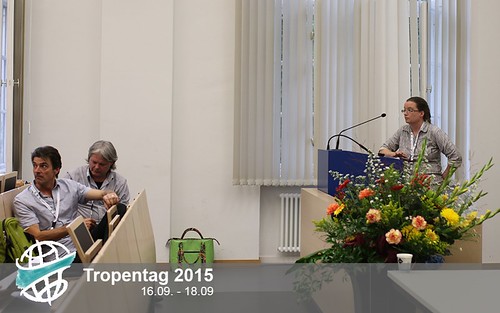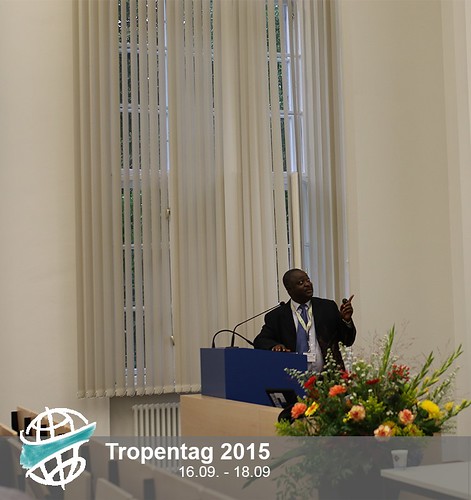Reply to comment
Some Expert Opinions: Chatting with the IITA
Sat, 09/19/2015 - 07:45 — Rachel Friedman
“We are placing research within development...These models are new, but I think they are working.” Bernard Vanlauwe from IITA argued during his closing keynote. Emerging mechanisms to approach agricultural research and how to link it to on-the-ground application were themes across the Centre’s research.
 Each year at Tropentag, one of the research centres of the CGIAR* is featured as a means of forging collaboration and furthering research for development. This year, the International Institute for Tropical Agriculture (IITA) filled that role, and works through partnerships and with farmers to improve food security and livelihoods. As the focal organization, IITA brought along a dozen or so experts, some of whom spared a moment to impart a few words of wisdom.
Interestingly, these scientists are not your stereotypical agronomists; they advocate approaching contemporary sectoral challenges from a systems perspective, often operating under title “systems agronomist”. I asked Alpha Yaya Kamara, a senior scientist leading the Water, Land, and Ecosystems (WLE) research programme, what this actually means. Basically, his work involves understanding not only how a specific crop fairs under certain conditions, but the integration of various biophysical and climatic factors (e.g. soils, hydrology, markets, etc.) affect the production and eventual sale of agricultural outputs. While it involves considerable amounts of modeling, he did note that “we learn a lot from the farmers,” as well.
Each year at Tropentag, one of the research centres of the CGIAR* is featured as a means of forging collaboration and furthering research for development. This year, the International Institute for Tropical Agriculture (IITA) filled that role, and works through partnerships and with farmers to improve food security and livelihoods. As the focal organization, IITA brought along a dozen or so experts, some of whom spared a moment to impart a few words of wisdom.
Interestingly, these scientists are not your stereotypical agronomists; they advocate approaching contemporary sectoral challenges from a systems perspective, often operating under title “systems agronomist”. I asked Alpha Yaya Kamara, a senior scientist leading the Water, Land, and Ecosystems (WLE) research programme, what this actually means. Basically, his work involves understanding not only how a specific crop fairs under certain conditions, but the integration of various biophysical and climatic factors (e.g. soils, hydrology, markets, etc.) affect the production and eventual sale of agricultural outputs. While it involves considerable amounts of modeling, he did note that “we learn a lot from the farmers,” as well.
 Sitting at the IITA both in the main hall, Christine Kreye, a natural resources management expert in the Humid Tropics research programme, echoes this sentiment. Her work focuses on intercropped cassava and legume intensification and connects to an innovation platform, one she noted as her favourite because the “real interaction” among the multiple stakeholders involved. The role of working with multiple stakeholders arose again later in a conversation with Laurence Jassogne. A project coordinator focusing on climate change impacts in perennial systems, she stressed the importance of looking at different levels, from the plant to institutions (see full interview here).
Each of these scientists signed off with a bit of advice for the youth of the conference. “Find a mentor,” Christine suggested, as there is unlikely a straight and narrow path to a career in the agricultural development field. Laurence advocated trying “to collaborate with a good group of people”. Luckily, there is considerable scope for working in agriculture, with Alpha stressing that the sector needs intelligent young scientists, and not necessarily out on the farms and the field, but also in labs and at computers.
*The CGIAR Consortium was formally established in 1971 (though the first centre was established in 1960). It consists of 15 research centres and nearly 10,000 scientists and staff, present in 96 countries.
Sitting at the IITA both in the main hall, Christine Kreye, a natural resources management expert in the Humid Tropics research programme, echoes this sentiment. Her work focuses on intercropped cassava and legume intensification and connects to an innovation platform, one she noted as her favourite because the “real interaction” among the multiple stakeholders involved. The role of working with multiple stakeholders arose again later in a conversation with Laurence Jassogne. A project coordinator focusing on climate change impacts in perennial systems, she stressed the importance of looking at different levels, from the plant to institutions (see full interview here).
Each of these scientists signed off with a bit of advice for the youth of the conference. “Find a mentor,” Christine suggested, as there is unlikely a straight and narrow path to a career in the agricultural development field. Laurence advocated trying “to collaborate with a good group of people”. Luckily, there is considerable scope for working in agriculture, with Alpha stressing that the sector needs intelligent young scientists, and not necessarily out on the farms and the field, but also in labs and at computers.
*The CGIAR Consortium was formally established in 1971 (though the first centre was established in 1960). It consists of 15 research centres and nearly 10,000 scientists and staff, present in 96 countries.
 Each year at Tropentag, one of the research centres of the CGIAR* is featured as a means of forging collaboration and furthering research for development. This year, the International Institute for Tropical Agriculture (IITA) filled that role, and works through partnerships and with farmers to improve food security and livelihoods. As the focal organization, IITA brought along a dozen or so experts, some of whom spared a moment to impart a few words of wisdom.
Interestingly, these scientists are not your stereotypical agronomists; they advocate approaching contemporary sectoral challenges from a systems perspective, often operating under title “systems agronomist”. I asked Alpha Yaya Kamara, a senior scientist leading the Water, Land, and Ecosystems (WLE) research programme, what this actually means. Basically, his work involves understanding not only how a specific crop fairs under certain conditions, but the integration of various biophysical and climatic factors (e.g. soils, hydrology, markets, etc.) affect the production and eventual sale of agricultural outputs. While it involves considerable amounts of modeling, he did note that “we learn a lot from the farmers,” as well.
Each year at Tropentag, one of the research centres of the CGIAR* is featured as a means of forging collaboration and furthering research for development. This year, the International Institute for Tropical Agriculture (IITA) filled that role, and works through partnerships and with farmers to improve food security and livelihoods. As the focal organization, IITA brought along a dozen or so experts, some of whom spared a moment to impart a few words of wisdom.
Interestingly, these scientists are not your stereotypical agronomists; they advocate approaching contemporary sectoral challenges from a systems perspective, often operating under title “systems agronomist”. I asked Alpha Yaya Kamara, a senior scientist leading the Water, Land, and Ecosystems (WLE) research programme, what this actually means. Basically, his work involves understanding not only how a specific crop fairs under certain conditions, but the integration of various biophysical and climatic factors (e.g. soils, hydrology, markets, etc.) affect the production and eventual sale of agricultural outputs. While it involves considerable amounts of modeling, he did note that “we learn a lot from the farmers,” as well. Sitting at the IITA both in the main hall, Christine Kreye, a natural resources management expert in the Humid Tropics research programme, echoes this sentiment. Her work focuses on intercropped cassava and legume intensification and connects to an innovation platform, one she noted as her favourite because the “real interaction” among the multiple stakeholders involved. The role of working with multiple stakeholders arose again later in a conversation with Laurence Jassogne. A project coordinator focusing on climate change impacts in perennial systems, she stressed the importance of looking at different levels, from the plant to institutions (see full interview here).
Each of these scientists signed off with a bit of advice for the youth of the conference. “Find a mentor,” Christine suggested, as there is unlikely a straight and narrow path to a career in the agricultural development field. Laurence advocated trying “to collaborate with a good group of people”. Luckily, there is considerable scope for working in agriculture, with Alpha stressing that the sector needs intelligent young scientists, and not necessarily out on the farms and the field, but also in labs and at computers.
*The CGIAR Consortium was formally established in 1971 (though the first centre was established in 1960). It consists of 15 research centres and nearly 10,000 scientists and staff, present in 96 countries.
Sitting at the IITA both in the main hall, Christine Kreye, a natural resources management expert in the Humid Tropics research programme, echoes this sentiment. Her work focuses on intercropped cassava and legume intensification and connects to an innovation platform, one she noted as her favourite because the “real interaction” among the multiple stakeholders involved. The role of working with multiple stakeholders arose again later in a conversation with Laurence Jassogne. A project coordinator focusing on climate change impacts in perennial systems, she stressed the importance of looking at different levels, from the plant to institutions (see full interview here).
Each of these scientists signed off with a bit of advice for the youth of the conference. “Find a mentor,” Christine suggested, as there is unlikely a straight and narrow path to a career in the agricultural development field. Laurence advocated trying “to collaborate with a good group of people”. Luckily, there is considerable scope for working in agriculture, with Alpha stressing that the sector needs intelligent young scientists, and not necessarily out on the farms and the field, but also in labs and at computers.
*The CGIAR Consortium was formally established in 1971 (though the first centre was established in 1960). It consists of 15 research centres and nearly 10,000 scientists and staff, present in 96 countries. 



